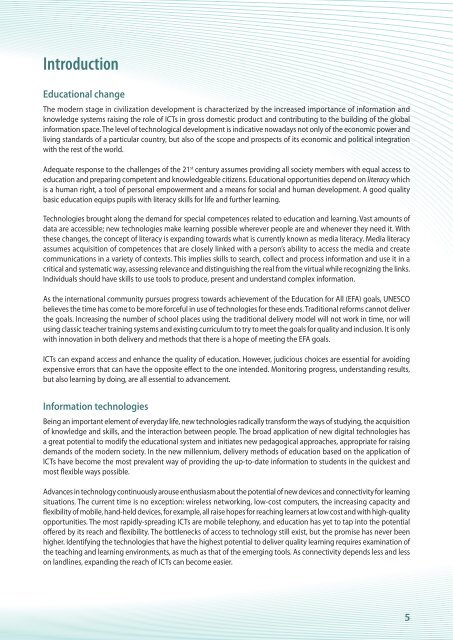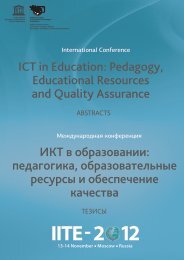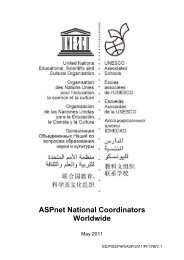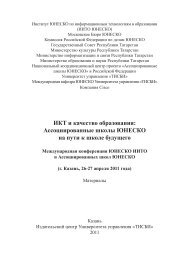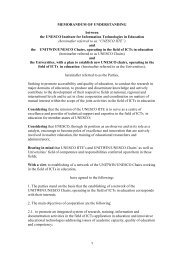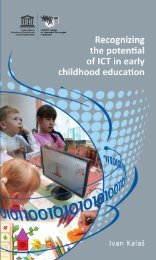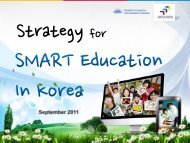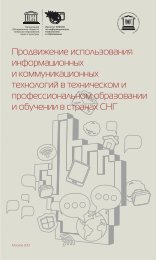Download PDF version - unesco iite
Download PDF version - unesco iite
Download PDF version - unesco iite
Create successful ePaper yourself
Turn your PDF publications into a flip-book with our unique Google optimized e-Paper software.
Introduction<br />
Educational change<br />
The modern stage in civilization development is characterized by the increased importance of information and<br />
knowledge systems raising the role of ICTs in gross domestic product and contributing to the building of the global<br />
information space. The level of technological development is indicative nowadays not only of the economic power and<br />
living standards of a particular country, but also of the scope and prospects of its economic and political integration<br />
with the rest of the world.<br />
Adequate response to the challenges of the 21 st century assumes providing all society members with equal access to<br />
education and preparing competent and knowledgeable citizens. Educational opportunities depend on literacy which<br />
is a human right, a tool of personal empowerment and a means for social and human development. A good quality<br />
basic education equips pupils with literacy skills for life and further learning.<br />
Technologies brought along the demand for special competences related to education and learning. Vast amounts of<br />
data are accessible; new technologies make learning possible wherever people are and whenever they need it. With<br />
these changes, the concept of literacy is expanding towards what is currently known as media literacy. Media literacy<br />
assumes acquisition of competences that are closely linked with a person’s ability to access the media and create<br />
communications in a variety of contexts. This implies skills to search, collect and process information and use it in a<br />
critical and systematic way, assessing relevance and distinguishing the real from the virtual while recognizing the links.<br />
Individuals should have skills to use tools to produce, present and understand complex information.<br />
As the international community pursues progress towards achievement of the Education for All (EFA) goals, UNESCO<br />
believes the time has come to be more forceful in use of technologies for these ends. Traditional reforms cannot deliver<br />
the goals. Increasing the number of school places using the traditional delivery model will not work in time, nor will<br />
using classic teacher training systems and existing curriculum to try to meet the goals for quality and inclusion. It is only<br />
with innovation in both delivery and methods that there is a hope of meeting the EFA goals.<br />
ICTs can expand access and enhance the quality of education. However, judicious choices are essential for avoiding<br />
expensive errors that can have the opposite eff ect to the one intended. Monitoring progress, understanding results,<br />
but also learning by doing, are all essential to advancement.<br />
Information technologies<br />
Being an important element of everyday life, new technologies radically transform the ways of studying, the acquisition<br />
of knowledge and skills, and the interaction between people. The broad application of new digital technologies has<br />
a great potential to modify the educational system and initiates new pedagogical approaches, appropriate for raising<br />
demands of the modern society. In the new millennium, delivery methods of education based on the application of<br />
ICTs have become the most prevalent way of providing the up-to-date information to students in the quickest and<br />
most fl exible ways possible.<br />
Advances in technology continuously arouse enthusiasm about the potential of new devices and connectivity for learning<br />
situations. The current time is no exception: wireless networking, low-cost computers, the increasing capacity and<br />
fl exibility of mobile, hand-held devices, for example, all raise hopes for reaching learners at low cost and with high-quality<br />
opportunities. The most rapidly-spreading ICTs are mobile telephony, and education has yet to tap into the potential<br />
off ered by its reach and fl exibility. The bottlenecks of access to technology still exist, but the promise has never been<br />
higher. Identifying the technologies that have the highest potential to deliver quality learning requires examination of<br />
the teaching and learning environments, as much as that of the emerging tools. As connectivity depends less and less<br />
on landlines, expanding the reach of ICTs can become easier.<br />
5


